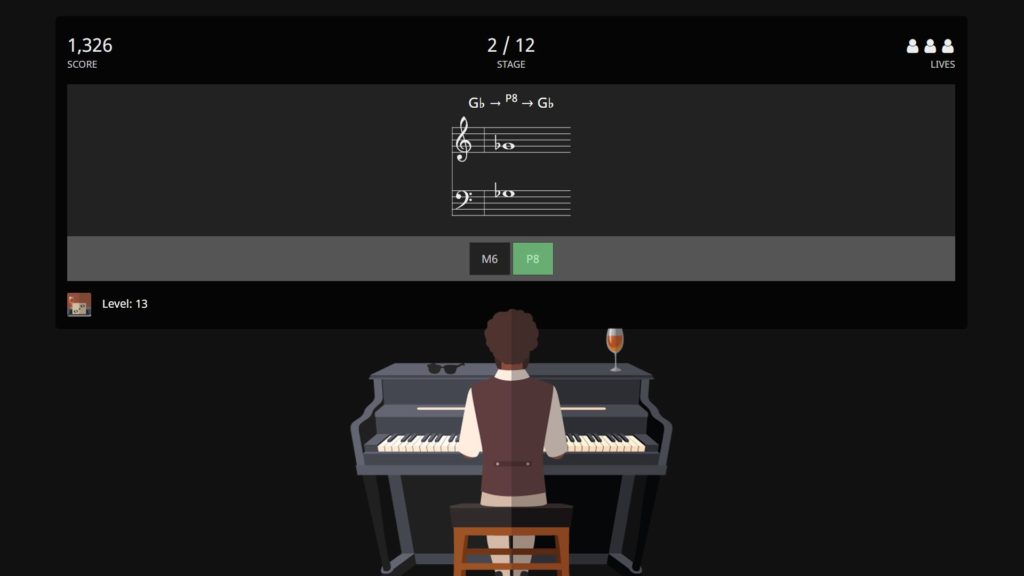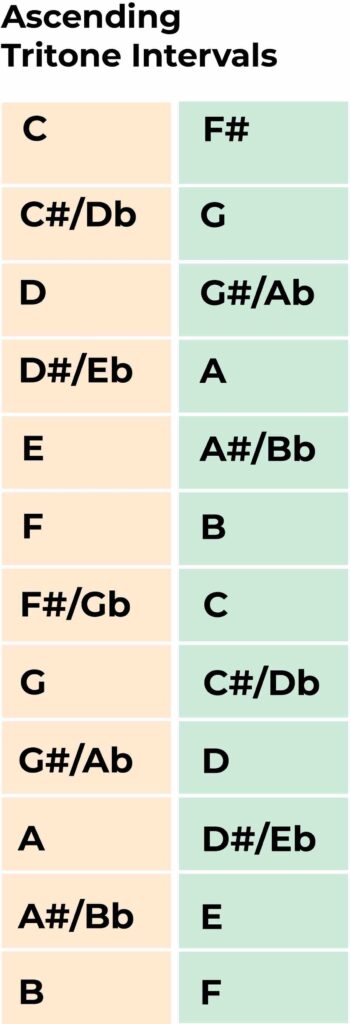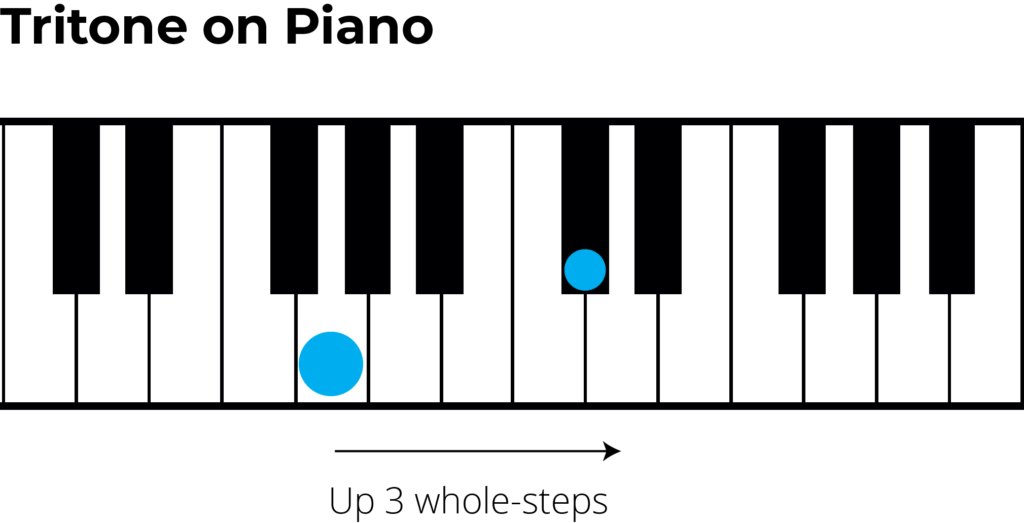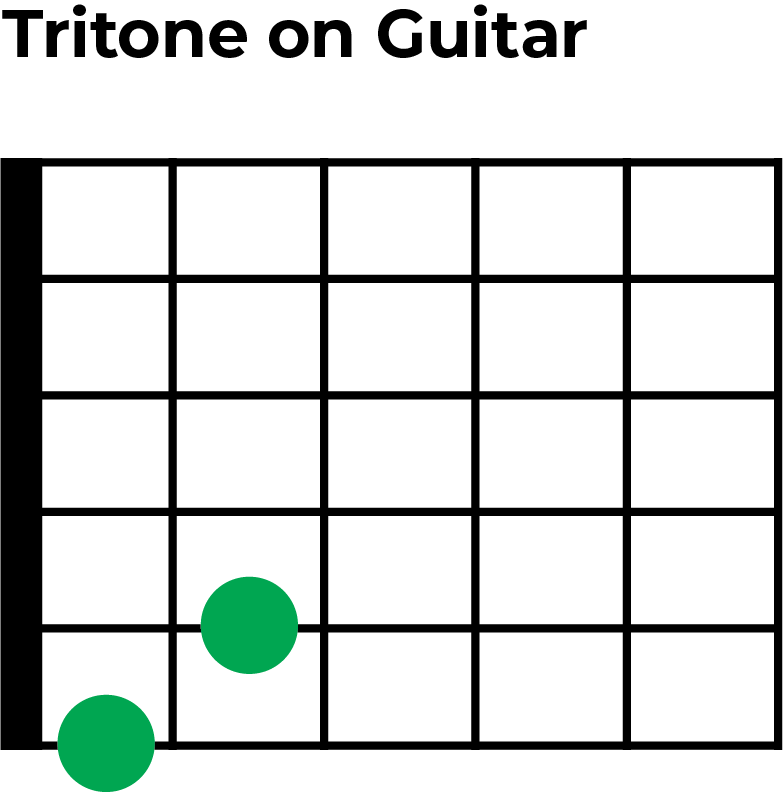Get ready to dive into the world of sound as we explore one of the most infamous intervals in music: the tritone. In this blog post, we’ll uncover the fascinating history of the tritone, from its devilish reputation to its rebellious rise in various musical genres. So, buckle up and let’s unravel the mysteries of the tritone together!
What is a Tritone Interval?
The tritone literally means ‘three-tones’ and so the interval is 3 whole steps or 3 tones. This places it in-between a perfect 4th and a perfect 5th. As both these intervals have such a consonant sound, the tritone interval between them his a very dissonant sound to it. It has been described as foreboding and has been referred to as the ‘devil’s interval’.
Below is an example of a tritone interval starting on C natural. Three tones above C is F sharp.

Because of its position between a perfect 4th and perfect 5th, we can also call a tritone an augmented 4th or diminished 5th.
C – F is a perfect 4th and if we raise a perfect interval we get an augmented interval, hence the augmented 4th. Alternatively, if we start from C – G, a perfect 5th, we can lower this a half-step. Lowering a perfect interval gives us a diminished 5th.
The History of the Devil’s Interval
A brief bit of history about this interval.
The tritone interval, also known as “the Devil’s interval” or “the forbidden interval,” has a shady reputation in the world of music. There is a ‘now debunked’ myth that the Catholic Church banned the tritone interval in 15th century because of its association with the devil. In fact, as Adam Nealy explain in his detailed video, the tritone was not thought of ‘summoning the Devil’ and was never actually banned.
As time went on, the tritone became a symbol of musical rebellion and edginess. Jazz musicians of the 20th century embraced it, using its tension-filled sound to create bold and adventurous melodies. The tritone even made its way into rock and metal music, where it became a favorite tool for adding a dark and sinister vibe to songs. Today, the tritone continues to challenge our ears and push the boundaries of musical expression.
Songs that use a Tritone
Here’s a selection of popular songs that use the tritone instrument. We’ve focussed on pieces where the tritone is a memorable part of the melody. This way it’s easy to remember!
The Simpsons Theme Song
Alright, folks, get ready for a musical journey down memory lane with the one and only Simpsons theme song! It’s that snappy little ditty that instantly transports you to the quirky and hilarious world of Springfield.
At the very start, the lyrics ‘The Simpsons’ contains the notes, C, F# and G. The C to F sharp is a tritone.

‘Purple Haze’ – Jimi Hendrix
The psychedelic rock masterpiece known as “Purple Haze” is by the legendary Jimi Hendrix. This mind-bending anthem takes you on a trippy ride with its electrifying guitar riffs and hypnotic lyrics.
The opening dissonant riff actually contains two tritone one after another. B flat – E natural and then E natural – Bb for to alternating intervals, both of which are tritone. This gives the the song an edgy start before the famous minor pentatonic riff takes over.

‘Black Sabbath’ – Black Sabbath
Prepare to immerse yourself in the depths of heavy metal as we explore the seminal composition “Black Sabbath” by the band, Black Sabbath. This song is characterized by its formidable guitar riffs and haunting vocal delivery and it stands as an anthem for rock and metal music.
The tritone interval is again present at the beginning of this song. The alternating notes of C sharp and the G natural above are three tones apart. This helps to give a dark and foreboding theme to the song.

‘YYZ’ – Rush
Rush’s rock instrumental masterpiece, ‘YYZ’ will have you air-drumming and headbanging like nobody’s business, with its killer bassline, intricate guitar work, and pulse-pounding rhythm.
The alternating between F sharp and C at the beginning of the song give us a tritone.

Ear Training and Intervals
To develop as a musician you’ll want to be able to recognise intervals by ear. This is where ear training comes in, as the more you practice, the better your’ll get.
My recommendation for this is Tonegym as they have a comprehensive and fun program for training your ears. It’s what has gotten the best results with for my own students.
In the ‘tools’ section of their site, Tonegym even have an interval memorizer that allows you to learn every type of interval.
For an in-depth look at ear training, here’s my full review of Tonegym.

Tritone Chart
Below is a chart that let you see ascending and descending tritones starting on any note.


Tritones on Piano
Here is a few examples of tritone played on the piano. Note that any two notes that are three tones apart with give you a tritone interval.

Tritones on Guitar
Below are guitar shapes that with give you a tritone interval. These can be moved up a down the neck to create tritones starting on different notes. In fact this is the shape used in ‘Purple Haze’ by Jimi Hendrix to play the opening tritone riff.

The Half-Diminished Seventh Chords: How the Tritone can sound heavenly
You may be thinking that the tritone is alway synonymous with dissonance and a darker sound. However, there is a ways to completely change its character by using harmony.
Below you can see a half-diminished seventh chord with a C root. This is made from a minor 3rd, diminished with (tritone) and minor 7th.

This chord is fairly rare, but is used to great effect in a ii, V, i progression to move the music back to the tonic chord. Below is an example from ‘You Never Give Me Your Money’ by The Beatles.

What’s next…?
- Learn more about seventh chords with our complete guide.
- Learn from our range of interval guides.
